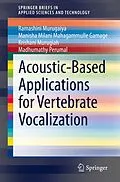Acoustic-Based Applications for Vertebrate Vocalization is designed to help researchers improve their findings and knowledge of vertebrate vocalization by focusing on the integration of acoustic features with new technologies, such as the Internet of Things (IoT), cloud computing, and virtual and cognitive reality. The book addresses the most common challenges in vertebrate vocalization-based research via suitable audio signal processing techniques, data collection, data pre-processing, acoustic feature engineering, extraction, and selection for multidisciplinary applications, i.e. feature classification, vertebrate communication, behavioral analysis, and signal pattern analysis. The book is an important reference for scholars, researchers, industry practitioners, teachers, and students across a number of disciplines, including bioengineering, audio engineering, systems engineering, biotechnology, signal processing, biology, zoology, and animal sciences.
Autorentext
Murugaiya Ramashini is a lecturer in the Department of Computer Science and Informatics at Uva Wellassa University, Sri Lanka. She received her Bachelor's in Information Technology and Master's in Engineering in Computer and Communication Engineering from Anna University. She has more than seven years of academic experience along with undergraduate research supervision knowledge. She was awarded The Best Portfolio in the 6th Certificate Course in Teaching in Higher Education (CTHE), by Uva Wellassa University, and from 2018 to 2021 obtained leave to attend Universiti Brunei Darussalam to pursue a PhD in Systems Engineering as a fully-funded research scholar. Miss Ramashini was selected in 2019 as a representative from Brunei to attend the Ewha-Luce International Seminar (ELIS) - Expanding Horizons organized by Ewha Womans University and Henry Luce Foundation as one of 19 outstanding PhD students in STEM from America and Asia. Her research interests are audio signal processing and machine learning.
Klappentext
Acoustic-Based Applications for Vertebrate Vocalization is designed to help researchers improve their findings and knowledge of vertebrate vocalization by focusing on the integration of acoustic features with new technologies, such as the Internet of Things (IoT), cloud computing, and virtual and cognitive reality. The book addresses the most common challenges in vertebrate vocalization-based research via suitable audio signal processing techniques, data collection, data pre-processing, acoustic feature engineering, extraction, and selection for multidisciplinary applications, i.e. feature classification, vertebrate communication, behavioral analysis, and signal pattern analysis. The book is an important reference for scholars, researchers, industry practitioners, teachers, and students across a number of disciplines, including bioengineering, audio engineering, systems engineering, biotechnology, signal processing, biology, zoology, and animal sciences.
Zusammenfassung
Acoustic-Based Applications for Vertebrate Vocalization is designed to help researchers improve their findings and knowledge of vertebrate vocalization by focusing on the integration of acoustic features with new technologies, such as the Internet of Things (IoT), cloud computing, and virtual and cognitive reality. The book addresses the most common challenges in vertebrate vocalization-based research via suitable audio signal processing techniques, data collection, data pre-processing, acoustic feature engineering, extraction, and selection for multidisciplinary applications, i.e. feature classification, vertebrate communication, behavioral analysis, and signal pattern analysis. The book is an important reference for scholars, researchers, industry practitioners, teachers, and students across a number of disciplines, including bioengineering, audio engineering, systems engineering, biotechnology, signal processing, biology, zoology, and animal sciences.
Inhalt
